North Cove, Suffolk (†St Edmundsbury & Ipswich) C.14
Passion Cycle
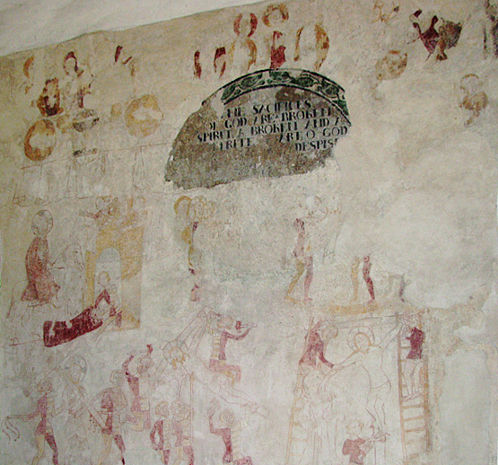
The general view at the left shows most of this Passion Cycle, which was probably painted in the early 14th century. Unusually situated (mainly) on the North Wall of the chancel, it is technically unsophisticated but full of intriguing details. There is some painting, perhaps a scene of the Washing of Feet, above the first chancel window (not shown here), but certainty is impossible. Otherwise, the first clearly identifiable scene, the Last Supper, is beyond this, at the top left of the picture. It is fairly clear, showing a table with a cloth, a central salt or chalice and two platters of fish. The head and part of the torso of Christ are visible at the table; he may be in the act of giving Judas the sop, but it is very hard to be sure. Judas is probably in his traditional position on the other side of the table, but that too is obscure.
Below this scene and pictured right below is the The Entry into Jerusalem. Christ, with the tripartite halo, is mounted on the Ass, before which a figure spreads a mat-like garment. The Gate of Jerusalem, shown as an arch and painted in yellow, is visible at the right. Several figures crowd on top of it, hailing the approaching Christ The garment-spreading man wears the parti-coloured garment worn by the torturers of Christ in later scenes, and it may be that the painter is deliberately emphasising the fact that those who welcome the Messiah are also those who will turn on him eventually – it is probably significant that those taking Christ down from the Cross in the Deposition are distinguished by their plain, single-coloured garments. Faint traces of an unidentifiable scene are visible to the right.
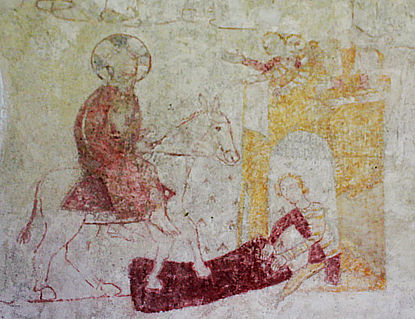
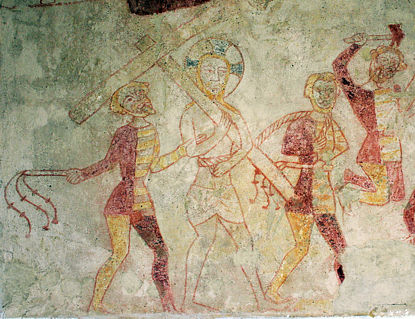
Below the Entry into Jerusalem and shown above right is the Road to Calvary with Christ carrying the Cross, led with a rope by one torturer and whipped by another with a cat-o’-nine tails scourge. Both again have faces made grotesque, and the man at the left is sticking out his tongue. To the right of this is a very curiously compressed scene which telescopes the setting up of the Cross and the spearing of Christ’s side by Longinus.
Christ Crucified is a very odd scene, in which the setting up of the Cross and the spearing of Christ’s side by Longinus are taking place simultaneously. Longinus is clearly visible, hand to newly-sighted eye in his usual posture. The Cross though is not upright, but slants dramatically on a left diagonal, and three soldiers are hammering in the nails preparatory to the hauling up of the Cross with the crucified Christ – their grotesquely ugly faces, especially that of the man at the upper right, show fairly well here.
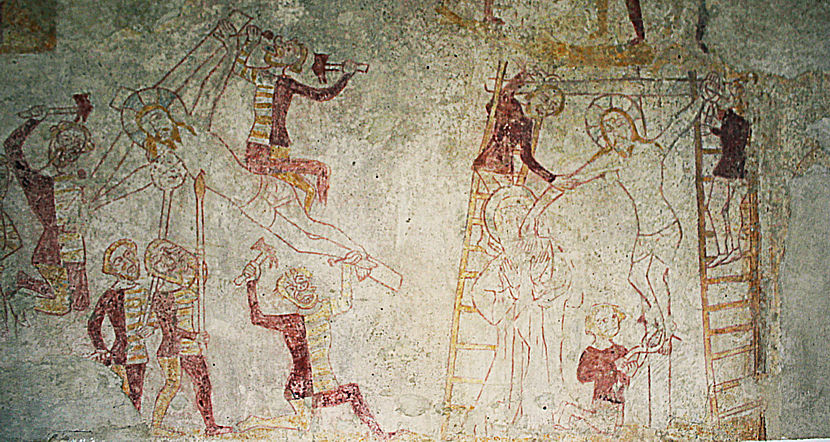
But the inclusion of Longinus delivering the death-blow, along with Stephaton presenting the sponge, makes nonsense of the timing; medieval painters usually found ways round the difficulty of depicting incidents following each other sequentially in the same space, but that has failed here, and the incidents are telescoped into confusion. What makes matters more difficult still is that there is no sign of Mary or John in the scene, and there is an area of wall above it where virtually all the painting has been lost Possibly this lost area may have been a traditional presentation of the Crucifixion, but that would still leave the question of why Longinus’s spearing of Christ’s side is where it is. I suspect that a garbled memory of what the painter saw happening in a play of the Crucifixion is at the root of this confusion.
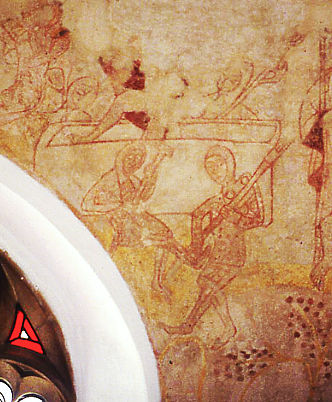
The Deposition, along with the scene above, is one of the clearest in the Cycle. Most of the details – ladders, men on them and the kneeling figure wielding the pincers at the bottom – are reasonably easy to see. The haloed figure standing in front of the left-hand ladder is now revealed as having hands raised in lamentation, introducing the possibility that this is Mary Magdalene or the Virgin rather than Joseph of Arimathea. This certainly does look like a female figure, but then again, so does St John in the Crucifixion at Turvey.
The Entombment at North Cove is barely discernible, but later scenes are clearer. At the right is the Resurrection, showing a rectangular coffin in which Christ stands, his right leg raised in the act of climbing out. The staff of the Vexillum or Banner of the Resurrection is very faintly visible (slanting diagonally upwards to the right from just above the top of the head of the soldier in the left foreground), but almost all the rest of Christ’s figure has been destroyed. At the extreme left at the top of the picture is a kneeling angel, but this is very difficult to see now. The remaining details though are much clearer. Two soldiers (the one at the left visibly asleep) slump in front of the sepulchre. They wear chainmail armour of the period of the painting and there are two more of them behind the tomb. The sleeping soldier in the left foreground holds an club-like object, but the three others have weapons broadly similar to lances or halberds but very curious in detail. They seem (especially that at the upper right) to have flattened blades with a hole in them, and if anyone has any idea what these are I would be glad to hear from them.
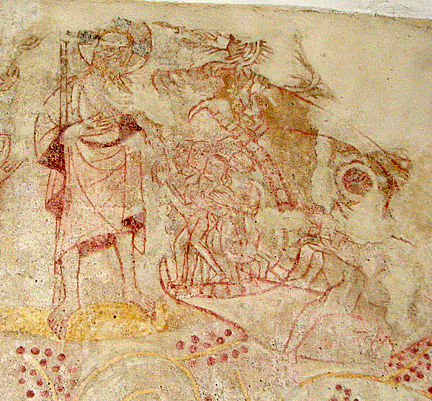
Shown left is the next scene in the Cycle, the Harrowing of Hell. A few examples remain in the English church; many more must have perished. There is a general formal resemblance here to the later example at Pickering (but no strategically-placed discs). So far as the Hell-Mouth itself is concerned, there is also a resemblance to Great Harrowden, but that again is later.
The theology of the Harrowing of Hell is complicated, and the fullest popular manifestation of it in the Middle Ages is certainly in drama.
For example, the Chester Harrowing of Hell, performed by the Cooks and Innkeepers, has all the necessary ingredients, including the defeat of Satan and the discomfiture of his cohorts, for impressing this difficult doctrine on the minds of ordinary folk. Humankind is in thrall to Satan after the Fall, until the crucified Christ, having paid with his death the necessary ransom, arrives at Hell’s gates, which cannot stand against him. In the plays, and in paintings like that at North Cove, medieval people saw his subsequent freeing of Adam, Eve, and the righteous who died before his Incarnation and Passion¹.
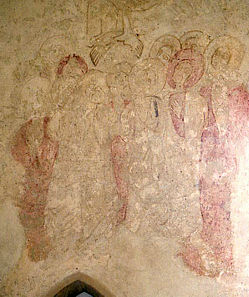
The final painting in the Cycle is the Ascension (left), opposite the others on the South Wall beside the Doom. It is of the most commonly found type in this period, with Christ’s feet and the hem of his robe disappearing into space at the top centre of the painting. At least twelve figures are gathered below, looking up. One of them is probably the Virgin Mary, who is often shown in Ascensions of this date, but I cannot identify her with certainty. There is also a pattern of vines with grapes surrounding all the paintings in the church, which shows best here in the Harrowing of Hell above.
(There is also a very interesting Doom of the same date at North Cove, also now updated with new photographs.)
All in all, this is one of the fullest and most interesting Passion Cycles remaining in the English parish church, made by a painter with a lively imagination. Perhaps the most distinctive thing about it is the choice of an unusually pale set of colours, but this makes it very difficult to photograph.
¹This is, needless to say, an extremely compressed and generalised sketch of medieval Ransom Theory.